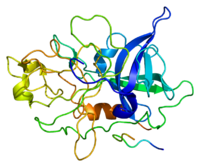
Photo from wikipedia
The urokinase plasminogen activator (uPA) and its cofactors are important regulators of tumor initiation and progression (including metastasis), and its overexpression is associated with unfavorable situations in cancer patients. We… Click to show full abstract
The urokinase plasminogen activator (uPA) and its cofactors are important regulators of tumor initiation and progression (including metastasis), and its overexpression is associated with unfavorable situations in cancer patients. We have previously used positron emission tomography (PET) imaging with a radiolabeled monoclonal antibody against the uPA (named ATN-291) to detect the uPA signaling activity in various cancer types; however, good tumor contrast can only be observed 24 h postinjection. To shorten the antibody circulation time and decrease interactions of ATN-291 with the mononuclear phagocyte system (MPS), our goal in this study is to develop an engineered antibody fragment (F(ab')2) from the parent antibody. By pepsin digestion and chromatography purification, ATN-291 F(ab')2 was obtained and characterized. Subsequently, it was conjugated with NOTA-Bn-NCS or fluorescein isothiocyanate (FITC) for PET imaging and fluorescence-mediated cellular analysis (i.e., flow cytometry or fluorescence microscopy). We confirmed that ATN-291 F(ab')2 still maintained a good targeting efficacy for the uPA in MDA-MB-231 cells (uPA+) and it had a faster blood clearance speed compared with ATN-291, while its interaction with MPS has been significantly decreased. In rodent tumor xenografts, radiolabeled ATN-291 F(ab')2 had a selective and persistent uptake in MDA-MB-231 tumors, with an early tumor-to-blood ratio of 1.3 ± 0.8 (n = 4) at 2 h postinjection from PET imaging. During our observation, radiolabeled ATN-291 F(ab')2 was excreted from both renal and hepatobiliary pathways. Radiolabeled ATN-291 F(ab')2 was also used for detecting uPA fluctuation during the tumor treatment in test animals. We concluded that radiolabeled ATN-291 F(ab')2 could be used as fast as PET cancer diagnostics with versatile applicability.
Journal Title: Molecular pharmaceutics
Year Published: 2021
Link to full text (if available)
Share on Social Media: Sign Up to like & get
recommendations!